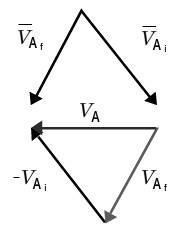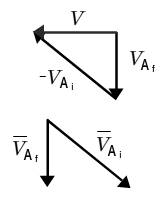
In the space provided, draw separate arrows representing the direction of the change in momentum vector of object A in the two experiments.
Direction of

Is the magnitude of the change in momentum of object A in experiment 1 greater than, less than, or equal to that in experiment 2? Explain.
The change in magnitude of the object
Explanation of Solution
Introduction:
Momentum has both magnitude as well as direction because it is a vector quantity. It is calculated by using the product of mass and velocity of object during motion. The total system’s momentum is equal to the vector summation of the individual momentum.
The change in momentum is given by product of mass and the change in velocity.
For experiment
The change in momentum is given by:
Thus, the direction of motion is along the velocity direction.
Therefore,
The change in momentum vector for experiment

For experiment

Magnitude of velocity vectors from both resultant velocity vectors:
Therefore, The change in object ‘s momentum for experiment
Conclusion:
The change in object’s momentum for experiment
Want to see more full solutions like this?
Chapter 17 Solutions
Tutorials in Introductory Physics
Additional Science Textbook Solutions
Introduction to Electrodynamics
College Physics
Essential University Physics (3rd Edition)
The Cosmic Perspective
Life in the Universe (4th Edition)
Physics (5th Edition)
- A 22-g bullet traveling 240 m/s penetrates a 2.0-kg block of wood and emerges going 150 m/s. If the block is stationary on a frictionless surface when hit, how fast does it move after the bullet emerges? please show your work, including diagrams, algebraic equations, and enough written explanations that somebody who is not familiar with the problem could understand what you are doing.arrow_forwardSolve numbers 1-3 with a full solution. 1. Compare the momentum of a 2000kg van moving at 30 m/s with a 5000kg truck moving at 12 m/s. 2. A 300 N force applied to an object for 10s. What is the impulse of the object?3. What is the momentum of a 1000kg car moves at 20 m/s?arrow_forwardPlease good handwriting and clear ideas explaining the process! 2-C)Just answer the highlighted question, if possible help me with the other onesarrow_forward
- Answer part C). If the blue object actually had an inital veloctiy of 50 m/s j, how long after the green projetile is launched should the blue object be launched if they are to collide? Let the blue object be traveling upward when they collide.arrow_forwardInstruction: I already have the answer in this problem but I can't understand some part of it. Look at the image posted to see what part I can't understand and please explain it. I can't understand "Part B". How did he came up with the formula, h3=e2h2? Topic: Impulse and Momentum A ball is dropped onto a horizontal floor. It reaches a height of 144 cm on the first bounce, and 81 cm on the second bounce. Find (a) the coefficient of restitution between the ball and floor and (b) the height it attains on the third bounce.arrow_forwardDuring an elastic collision, a proton with a velocity of 5000 m/s (forward) undergoes a head on collision with an alpha particle (composed of two protons and two neutrons) with a velocity of 2000m/s (backward). Determine the final velocities of the subatomic particles. Assume forward is positive. Show all your work please.arrow_forward
- I need help with part C and D, please explain step by steparrow_forwardWhen a chronometer begins with a time of zero seconds, two soccer balls share a common height, h1, above the ground, and they have a horizontal separation, d. The ball on the left has a horizontal velocity with magnitude v0 directed toward the right, and the other soccer ball is momentarily at rest. A short time later, the two soccer balls collide at the collision point, C, at a height h2 above the ground, as indicated on the diagram. Ignore the finite size of the balls, and additionally ignore any air resistance. given d= 8.03 m, h1= 2.12 m, h2= 1.19 m compute the elasped time in seconds at which the two balls collide given d= 8.03 m, h1= 2.12 m, h2= 1.19 m compute the magnitude in m/s of the iniital velocity of the ball on the leftarrow_forwardPlease see attached photo. I am confused as to how they got the i value mostly. I think c threw me off ( i used 31cos270 to try to find the value= -31) so please eloaborate on that. I kept getting 33 or 34 for the i value. I got 87 for the j value so I think i did that part correctly?arrow_forward
- Please explain step by step, I need help with part C and Earrow_forwardA golfer starts with the club over her head and swings it to reach maximum speed as it contacts the ball. Halfway through her swing, when the golf club is parallel to the ground, does the acceleration vector of the club head point (a) straight down, (b) parallel to the ground, approximately toward the golfer's shoulders, (c) approximately toward the golfer's feet, or (d) toward a point above the golfer's head? Explain. Match the words in the left column to the appropriate blanks in the sentences on the right. The club head undergoes circular motion so it has a _____ acceleration. As the speed of the club head is increasing, it also has an acceleration component _________. Thus, the acceleration vector is pointed as described in _________.arrow_forwardA golfer starts with the club over her head and swings it to reach maximum speed as it contacts the ball. Halfway through her swing, when the golf club is parallel to the ground, does the acceleration vector of the club head point (a) straight down, (b) parallel to the ground, approximately toward the golfer's shoulders, (c) approximately toward the golfer's feet, or (d) toward a point above the golfer's head? Explain. Match the words in the left column to the appropriate blanks in the sentences on the right.arrow_forward
 Principles of Physics: A Calculus-Based TextPhysicsISBN:9781133104261Author:Raymond A. Serway, John W. JewettPublisher:Cengage Learning
Principles of Physics: A Calculus-Based TextPhysicsISBN:9781133104261Author:Raymond A. Serway, John W. JewettPublisher:Cengage Learning AstronomyPhysicsISBN:9781938168284Author:Andrew Fraknoi; David Morrison; Sidney C. WolffPublisher:OpenStax
AstronomyPhysicsISBN:9781938168284Author:Andrew Fraknoi; David Morrison; Sidney C. WolffPublisher:OpenStax

